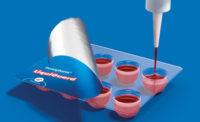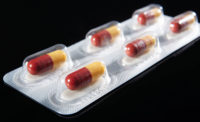Materials
Blister Packaging Expands Performance in Pharma Industry
Blister packaging has been adopted as the packaging format by pharmaceutical companies to protect the product from external factors.




There are a wide range of solutions that can be used to increase the shelf life of capsules, tablets, pills and other pharma products. Among these are PVC, PCTFE, PVDC and thermoform blisters for less sensitive products or Alu-Alu cold form blisters for Active Pharmaceutical Ingredients (APIs) that are more sensitive.
Many of the advantages inherent in the blister pack design are aligned with the current demands of the pharmaceutical industry. As a result, blister packs have been and will continue to be one of the fastest growing packaging options in the industry. The demands of the pharmaceutical industry, which are focused on safe and tamper-evident packaging, continue to shape the blister pack market. For example, the mix of forming web structures is trending towards higher barrier options in response to more sophisticated drugs. Top webs are also becoming more complex with the shift towards compliance packs and regulatory requirements, coupled with the increasing demand for child-resistant formats.
The flexible packaging market for pharmaceuticals continues to demonstrate strong growth with an estimated compounded annual growth rate of 2.1% during the forecast period 2018-2023 for the oral solid dose product format. The increasing use of blister packaging in the U.S. pharmaceutical market continues to evolve for several reasons. Key drivers include drug safety and efficacy, drug sensitivity, child resistance, anti-counterfeiting, patient compliance, economics/environmental and regulatory changes.
Shelf-Life Requirements Get Stiffer
Many pharmaceutical companies today face challenges to extend product shelf life, maximize production efficiency, and improve speed to market. Packaging solutions need to meet these commercial demands and enhance quality for patients, while also addressing the specific requirements for the pharmaceutical products. Conventional blister packs are a proven solution for protecting pharmaceutical products, and are a convenient solution for patients, since they are easy to carry and use on-the-go. However, in some extreme conditions — such as tropical climates or for highly moisture-sensitive products — there is a need for extra product protection.
One such product is an antibiotic by GSK for use in the Pakistan market. Amcor has worked in partnership with GSK and Italy-based machine manufacturer CAM-Partena to develop a packaging solution that provides added protection for this specific API, which is highly sensitive to moisture. This collaboration resulted in a solution based on Amcor’s Formpack Dessiflex Ultra, a desiccant blister system with a special lidding foil.
The new blister system offers many advantages over the previous solution of tablets inside a glass bottle, as well as over standard aluminum blister packs due to its enhanced moisture protection. It is a smarter alternative to adding a desiccant wad or sachet to the six tablets within a glass container, as it removes ingestion risk for the patient.
For any standard aluminum blister, moisture can still enter the cavity via cross diffusion through the seal layer or as part of the tablet packaging process. Formpack Dessiflex Ultra provides extra protection by absorbing any moisture before it enters the cavity, and by drying the atmosphere of the cavity after the packaging process. This extra protection ensures each dose reaches the patient correctly.
The newly launched desiccant blister pack is manufactured using Amcor’s Dessiflex Ultra blister base material and Amcor’s 20-micron aluminum blister lidding material. Each blister contains six tablets (the same as the current glass bottle). The new pack has a moisture absorbent seal layer of unrivalled high absorption capacity (>6.2g/m2). It can therefore absorb any moisture that enters the cavity by cross diffusion and keep each individual tablet dry throughout the whole storage time (shelf life). Each tablet is therefore protected by the desiccant blister material until it is removed by the patient prior to dosing. This ensures that each tablet has the optimum protection and maintains the highest quality (minimum degradation) until point of taking.
Enhanced Consumer Experience
The previous glass container of six tablets used a desiccant wrap, sealed using an aluminum pilfer-proof closure with a liner. While this is a safe and effective solution, blister packaging allows patients to access each individual tablet. This makes it easier to keep track of the number of tablets taken, thereby assisting with patient adherence. Patients can also be assured of the medicine’s authenticity because the colored Dessiflex inner layer (in green) makes it harder to counterfeit. And the replacement of the previous glass packaging improves safety for line operators by reducing the risk of breakage during production and allows manufacturers such as GSK to simplify its production lines by removing the need to insert a desiccant sachet. Replacing a breakable material also reduces the risk of contamination, which could result in waste. A glass bottle is heavier than a blister pack and therefore less convenient for the patient to carry as well.
Not only do suppliers including Amcor offer unique packaging products but also logistic/service models aligned to customer needs. These include short-run printing to secure security of supply and short lead times, and smart packaging solutions.
Looking for a reprint of this article?
From high-res PDFs to custom plaques, order your copy today!









